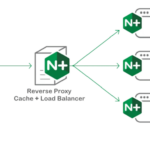Using nginx_modsite command similar for use a2ensite and a2dissite with NGINX

As we all know, we can enable or disable a website using Apache on Debian and Ubuntu Linux. We remembered and appreciated using the a2ensite and a2dissite commands, why not for NGINX!
Unfortunately, there is no corresponding standard command in NGINX, but there is a workaround using a2ensite and a2dissite for NGINX.
Of course, the following command can create the symlink to the website configuration file:
$ sudo ln -s /etc/nginx/sites-available/example.org /etc/nginx/sites-enabled/As well as we can unlink the site from enabled sites:
$ sudo unlink /etc/nginx/sites-enabled/example.orgnginx_modsite command for NGINX
The nginx_modsite command for use enable and disablbe NGINX websites and also list them.
Easy to use nginx_modsite
Just create this script file /usr/bin/nginx_modsite.
#!/bin/bash
##
# File:
# nginx_modsite
# Description:
# Provides a basic script to automate enabling and disabling websites found
# in the default configuration directories:
# /etc/nginx/sites-available and /etc/nginx/sites-enabled
# For easy access to this script, copy it into the directory:
# /usr/local/sbin
# Run this script without any arguments or with -h or --help to see a basic
# help dialog displaying all options.
##
# Copyright (C) 2010 Michael Lustfield <mtecknology@ubuntu.com>
# Redistribution and use in source and binary forms, with or without
# modification, are permitted provided that the following conditions
# are met:
# 1. Redistributions of source code must retain the above copyright
# notice, this list of conditions and the following disclaimer.
# 2. Redistributions in binary form must reproduce the above copyright
# notice, this list of conditions and the following disclaimer in the
# documentation and/or other materials provided with the distribution.
#
# THIS SOFTWARE IS PROVIDED BY AUTHOR AND CONTRIBUTORS ``AS IS'' AND
# ANY EXPRESS OR IMPLIED WARRANTIES, INCLUDING, BUT NOT LIMITED TO, THE
# IMPLIED WARRANTIES OF MERCHANTABILITY AND FITNESS FOR A PARTICULAR PURPOSE
# ARE DISCLAIMED. IN NO EVENT SHALL AUTHOR OR CONTRIBUTORS BE LIABLE
# FOR ANY DIRECT, INDIRECT, INCIDENTAL, SPECIAL, EXEMPLARY, OR CONSEQUENTIAL
# DAMAGES (INCLUDING, BUT NOT LIMITED TO, PROCUREMENT OF SUBSTITUTE GOODS
# OR SERVICES; LOSS OF USE, DATA, OR PROFITS; OR BUSINESS INTERRUPTION)
# HOWEVER CAUSED AND ON ANY THEORY OF LIABILITY, WHETHER IN CONTRACT, STRICT
# LIABILITY, OR TORT (INCLUDING NEGLIGENCE OR OTHERWISE) ARISING IN ANY WAY
# OUT OF THE USE OF THIS SOFTWARE, EVEN IF ADVISED OF THE POSSIBILITY OF
# SUCH DAMAGE.
##
# Default Settings
##
NGINX_CONF_FILE="$(awk -F= -v RS=' ' '/conf-path/ {print $2}' <<< $(nginx -V 2>&1))"
NGINX_CONF_DIR="${NGINX_CONF_FILE%/*}"
NGINX_SITES_AVAILABLE="$NGINX_CONF_DIR/sites-available"
NGINX_SITES_ENABLED="$NGINX_CONF_DIR/sites-enabled"
SELECTED_SITE="$2"
##
# Script Functions
##
ngx_enable_site() {
[[ ! "$SELECTED_SITE" ]] &&
ngx_select_site "not_enabled"
[[ ! -e "$NGINX_SITES_AVAILABLE/$SELECTED_SITE" ]] &&
ngx_error "Site does not appear to exist."
[[ -e "$NGINX_SITES_ENABLED/$SELECTED_SITE" ]] &&
ngx_error "Site appears to already be enabled"
ln -sf "$NGINX_SITES_AVAILABLE/$SELECTED_SITE" -T "$NGINX_SITES_ENABLED/$SELECTED_SITE"
ngx_reload
}
ngx_disable_site() {
[[ ! "$SELECTED_SITE" ]] &&
ngx_select_site "is_enabled"
[[ ! -e "$NGINX_SITES_AVAILABLE/$SELECTED_SITE" ]] &&
ngx_error "Site does not appear to be \'available\'. - Not Removing"
[[ ! -e "$NGINX_SITES_ENABLED/$SELECTED_SITE" ]] &&
ngx_error "Site does not appear to be enabled."
rm -f "$NGINX_SITES_ENABLED/$SELECTED_SITE"
ngx_reload
}
ngx_list_site() {
echo "Available sites:"
ngx_sites "available"
echo "Enabled Sites"
ngx_sites "enabled"
}
##
# Helper Functions
##
ngx_select_site() {
sites_avail=($NGINX_SITES_AVAILABLE/*)
sa="${sites_avail[@]##*/}"
sites_en=($NGINX_SITES_ENABLED/*)
se="${sites_en[@]##*/}"
case "$1" in
not_enabled) sites=$(comm -13 <(printf "%s\n" $se) <(printf "%s\n" $sa));;
is_enabled) sites=$(comm -12 <(printf "%s\n" $se) <(printf "%s\n" $sa));;
esac
ngx_prompt "$sites"
}
ngx_prompt() {
sites=($1)
i=0
echo "SELECT A WEBSITE:"
for site in ${sites[@]}; do
echo -e "$i:\t${sites[$i]}"
((i++))
done
read -p "Enter number for website: " i
SELECTED_SITE="${sites[$i]}"
}
ngx_sites() {
case "$1" in
available) dir="$NGINX_SITES_AVAILABLE";;
enabled) dir="$NGINX_SITES_ENABLED";;
esac
for file in $dir/*; do
echo -e "\t${file#*$dir/}"
done
}
ngx_reload() {
read -p "Would you like to reload the Nginx configuration now? (Y/n) " reload
[[ "$reload" != "n" && "$reload" != "N" ]] && invoke-rc.d nginx reload
}
ngx_error() {
echo -e "${0##*/}: ERROR: $1"
[[ "$2" ]] && ngx_help
exit 1
}
ngx_help() {
echo "Usage: ${0##*/} [options]"
echo "Options:"
echo -e "\t<-e|--enable> <site>\tEnable site"
echo -e "\t<-d|--disable> <site>\tDisable site"
echo -e "\t<-l|--list>\t\tList sites"
echo -e "\t<-h|--help>\t\tDisplay help"
echo -e "\n\tIf <site> is left out a selection of options will be presented."
echo -e "\tIt is assumed you are using the default sites-enabled and"
echo -e "\tsites-disabled located at $NGINX_CONF_DIR."
}
##
# Core Piece
##
case "$1" in
-e|--enable) ngx_enable_site;;
-d|--disable) ngx_disable_site;;
-l|--list) ngx_list_site;;
-h|--help) ngx_help;;
*) ngx_error "No Options Selected" 1; ngx_help;;
esacMake the script executable with ran chmod 700 /usr/bin/nginx_modsite.
Using the command nginx_modsite
To list all available virtualhosts, you can run the following command.
$ sudo nginx_modsite -lEnable virtualhost “example.org”.
$ sudo nginx_modsite -e example.orgDisable virtualhost “example.org”.
$ sudo nginx_modsite -d example.orgAbout NGINX
Nginx “engine x” is an open source web server that can also be used as a reverse proxy, load balancer, mail proxy and HTTP cache. The software was created by Russian developer Igor Sysoev and publicly released in 2004. Nginx is free and open-source software, released under the terms of the 2-clause BSD license. A large fraction of web servers use Nginx, often as a load balancer.
Nginx is built to offer low memory usage and high concurrency. Rather than creating new processes for each web request, Nginx uses an asynchronous, event-driven approach where requests are handled in a single thread.
With Nginx, one master process can control multiple worker processes. The master maintains the worker processes, while the workers do the actual processing. Because Nginx is asynchronous, each request can be executed by the worker concurrently without blocking other requests.
Nginx vs Apache Usage Stats
Apache is another popular open source web server. In terms of raw numbers, Apache is the most popular web server in existence and is used by 43.6% (down from 47% in 2018) of all websites with a known web server, according to W3Techs. Nginx comes in a close second at 41.8%.
Netcraft ran a survey across 233 million domains and found Apache usage at 31.54% and Nginx usage at 26.20%.



